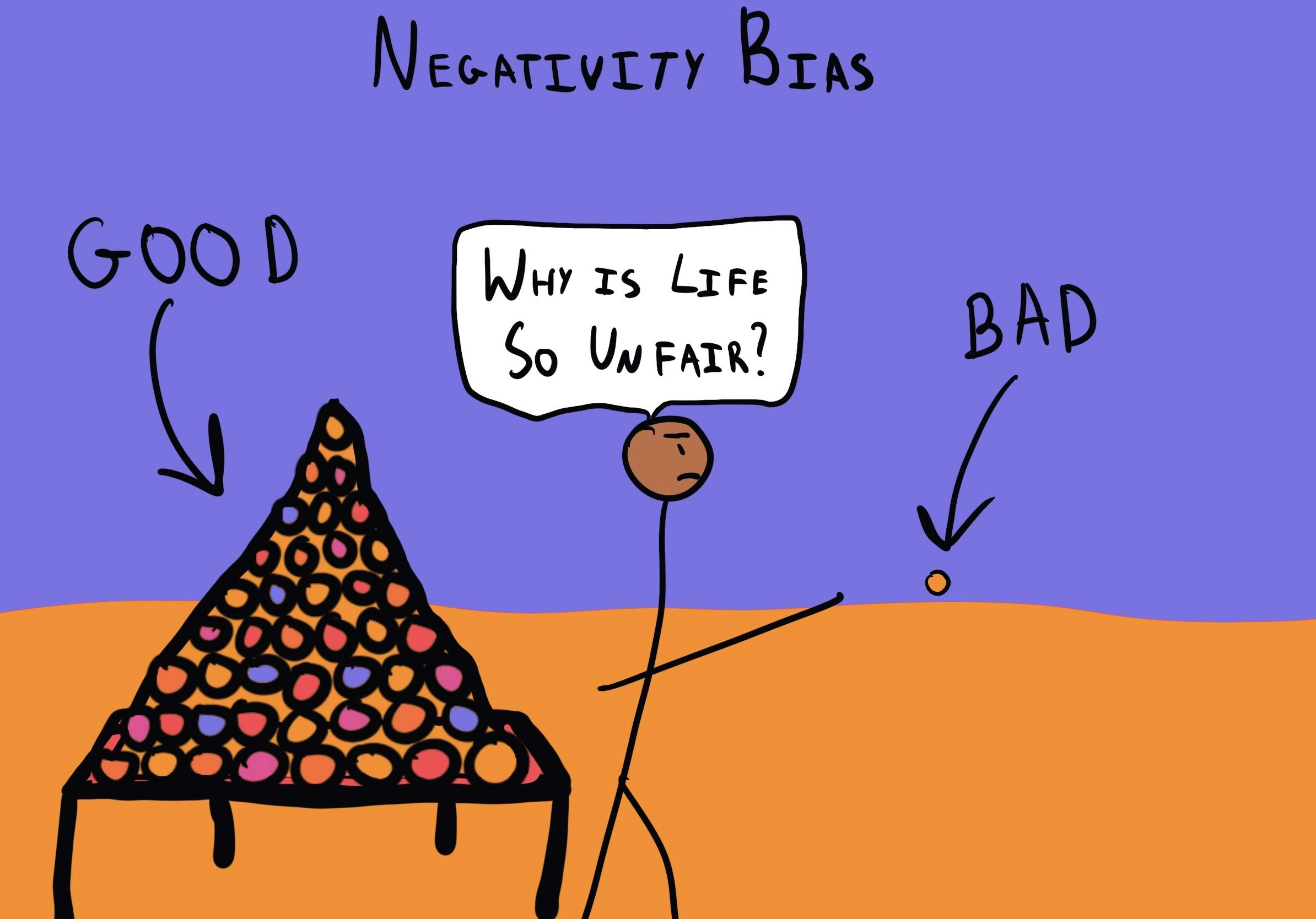Why is the news always so depressing?
Negativity Bias
, explained.What is the Negativity Bias?
The negativity bias is a cognitive bias that results in adverse events having a more significant impact on our psychological state than positive events. Negativity bias occurs even when adverse events and positive events are of the same magnitude, meaning we feel negative events more intensely.1

Where this bias occurs
Negativity bias is a well-studied and long-understood concept. Negativity bias causes amplified emotional responses to negative events compared to positive events of equal magnitude. Negativity bias is linked to loss aversion, a cognitive bias that describes why the pain of losing is psychologically twice as powerful as the pleasure of gaining.2
Much of today’s political discourse occurs online and while this may expose us to greater perspectives, it also leaves the door open for misunderstanding. We often criticize “the other side” and assume ill-intent when we read political posts that don’t align with our values. And while sometimes there is hostility imbedded certain content, it isn’t always the case. Because of our predisposition to focus on and scrutinize the negative, posts that express anger or hostility grab our attention and inform our perceptions. By nature, we extrapolate and then use these negative impressions to cast future judgment.
Debias Your Organization
Most of us work & live in environments that aren’t optimized for solid decision-making. We work with organizations of all kinds to identify sources of cognitive bias & develop tailored solutions.
Related Biases
Individual effects

The negativity bias has a significant impact on our individual decision-making. Because we spend so much time scrutinizing negative memories we tend to keep this information at the front of our minds, affecting our future choices. However, while being cautious can be a good thing, the negativity bias can deter us from using logic and reasoning leading to poorly thought-out decisions, and possibly, unfavorable outcomes.
Interestingly, the negativity bias may play a role in beliefs about self-efficacy as well as our self-esteem. During our most formative years we already begin to develop beliefs about our abilities which can translate to changes in our performance. To measure this, Müller-Pinzler and colleagues constructed the “learning of own performance” (or LOOP) task, where participants were given direct feedback on their abilities. They found that individuals show a negativity bias toward updating their own performance, but when listening to the feedback on the performance of others, they attended equally to positive and negative information.
While this may help us to recognize our mistakes, the authors warn that the negativity bias is not something to be taken lightly. Primarily attending to and giving more weight to negative information can lead us to forming harmful beliefs about our competence and general ability. This can contribute to low self-esteem and anxiety, bleeding into many aspects of our lives.17
Systemic effects
Being too risk-averse and letting negativity bias cloud decision-making can have significant consequences on outcomes. For corporations in competitive and volatile markets, negativity bias can significantly affect competitive advantages.
An example of systemic challenges resulting from the negativity bias can be seen in the case of Kodak, once the world’s leading film photography company. When the market began shifting towards digital photography, Kodak was too risk-averse to innovate its products. Negativity bias prevented Kodak from seizing its competitive advantage and market presence to continue to develop to maintain mainstream success. Instead, Kodak focused on what they identified as their core strength, film photography, which eventually became an outdated industry. This business decision made Kodak lose its competitive position to rival photography companies like Sony, Fujifilm, and Canon, all of which adapted to the changing photography landscape. As a result, Kodak filed for bankruptcy in 2002.5
Negativity bias can prevent organizations from innovating and taking necessary risks to adjust to changing consumer needs. By avoiding negativity bias from clouding decision-making, corporations and individuals can make better, calculated decisions without bias.
How it affects product
As discussed above, negativity bias can hold companies back from exploring other ventures. It is strategic to weigh both the pros and cons before beginning a new project, but holding back for too long can lead to companies losing their advantage or missing the ideal entry to a new market.
Negativity bias also plays a massive role in terms of brand reputation and customer reviews. Because we are prone to pay more attention to negative information, even a few poor product reviews can cause a consumer to think twice before investing in the item or service. We let this type of information affect us more, leading us to put more weight on negative reviews. Managing and responding to negative reviews in a constructive and public manner can help to mitigate these effects. Showing potential customers that you stand behind your product and are confident in your ability to resolve any issue may also increase brand loyalty and prompt new consumers to try your product.
Negativity bias and AI
Social media algorithms are designed to ensure that you are delivered content similar to what you interact with on a daily basis. Globally, we pay more attention to negative media, and when presented with this type of content, we tend to have a stronger reaction.15 The more time you spend reading and engaging with a specific type of post or video, the more that kind of content will pop up on your newsfeed and recommended tabs. Because we’re predisposed to focus more on negative content, we process it more carefully than positive stimuli, thus devoting more time to it.16 In doing this, certain news stories or sources get pushed into our feeds, allowing us to consume the same type of content.
However, the good thing about algorithms is that they can change. By engaging with positive news along with more serious or negative content, one can diversify their feeds and bring a little more positivity to their social media experience.
Why it happens
Paul Rozin and Edward Poyzman, the researchers who coined negativity bias, have identified four elements that explain why the bias manifests: negative potency, steeper negative gradients, negativity dominance, and negative differentiation.6
Negative Potency
Negative potency describes the idea that though negative and positive events or memories may be equal in magnitude or emotionality, they are not necessarily equally salient. Simply put, these events stick out to us. We feel the consequences of negative events much more.6
Steeper Negative Gradients
Rozin and Royzman refer to negative and positive gradients as the perceived emotional slope of an event. For example, an upcoming dental surgery is regarded as increasingly negative as the date of the appointment approaches, meaning there is a steep negative gradient. The researchers found that positive developments then have a flatter gradient in comparison to adverse events.6
Negativity Dominance
Rozin and Royzman describe negative dominance as the tendency for ambiguous events to skew towards an overall negative interpretation. This interpretation overshadows the actual average sum of our positive and negative components. To summarize, we typically view the whole of an event or moment as more negative than the sum of its parts.6
Negative Differentiation
Negative differentiation states that since negative events are more complicated than their positive counterparts, we require a more significant mobilization of cognitive resources to minimize the event's consequences and deal with the experience, making it a more memorable and intense experience.7
Negative differentiation is consistent with substantial research indicating that negative emotions are more complicated than positive ones. Research studies have suggested that as a result of this complexity, human vocabulary describing negative emotions and events is much more vibrant and descriptive than positive vocabulary.8
Why it is important
Negativity bias significantly impacts how we make decisions, motivate ourselves, and interact with one another.
Decision-Making
We should be aware of the negativity bias as it can significantly impact our decision-making ability. When making decisions, individuals who fall prey to negativity bias typically outweigh or focus too heavily on an outcome’s potential costs or negatives.1 Skewing risk and possible adverse outcomes could lead to poor decision-making.
Motivation
Psychological research suggests that negativity bias impacts our motivation and ability to complete tasks. We have more motivation to complete a job when we are trying to avoid a loss than if we are motivated by a means to gain something. Based on whether an action is framed in a positive or negative context can change how driven we are to complete a task.9
How to avoid it
To avoid negativity bias, we must first understand the bias and acknowledge how it can develop in our thinking and decision-making. Once a general understanding grows, we can do the following to avoid negative bias:
Mindfulness
A study conducted in 2011 by Kiken and Shook found that practicing mindful breathing, a form of meditation, increased positive judgments and engaged higher levels of optimism in participants. Compared to other control groups, participants who practiced mindful breathing performed better at tests requiring them to categorize positive stimuli. Researchers identified that mindfulness practice significantly impacts the negativity bias.11
Focus on the Positive
Negativity bias affects us by making us have a stronger reaction to negative events compared to positive onesAn exercise to curb this bias would include focusing on positive events and savoring those experiences to create positive memories. Attempting to engage fully in pleasant sensations, and reflect on the positive developments occurring at the moment.12
How it all started
Negativity bias is assumed to have been an adaptive evolutionary function developed by humans thousands of years ago. By continually being exposed to immediate environmental threats, our ancestors developed a negativity bias to survive.13
Psychologists Paul Rozin and Edward Royzman first documented negativity bias in their 2001 paper, “Negativity Bias, Negativity Dominance, and Contagion.” The paper hypothesized that humans and animals give higher weight to negative entities and that this manifested in 4 different ways: negative potency, steeper negative gradients, negativity dominance, and negative differentiation. These four concepts have been widely publicized and used to analyze negativity bias. The researchers suggested that adverse events seem to be dominant as negative entities are more contagious than positive entities.6
Example 1 – Stimuli
A study conducted in 1998 by Tiffany Ito and colleagues concluded that humans react more intensely to negative stimuli, be it pictures, videos, or words. The study was conducted by showing each participant 33 different photos and measuring their brains’ electrical activity to identify their responses. The researchers presented neutral images (such as a plate and an electrical outlet), positive photos (such as people enjoying themselves), and negative images (such as a gun pointed to the individual holding the picture).14
The researchers found that images that generated the most brain activity, also called Event-Related Brain Potentials (ERPs), occurred when participants held the negative images. Thus, the results concluded that individuals naturally responded more intensely to negative stimuli than neutral or positive stimuli.3
Example 2 – Media
It is common to feel like the news is filled with only negative and dark stories. Researchers initially hypothesized that negative coverage is more attractive and attention-grabbing for potential readers and customers, especially compared to positive coverage.
Research conducted by Dr. Soroka and her colleagues in 2019 investigated whether demand for negative information is as prevalent as assumed and if that desire for negative stories is globally consistent. Her study reported results from 17 different countries across six continents. Specifically, she examined the psychophysiological reactions to video news content and the effect on individuals consuming these videos. The study concluded that globally, humans are more physiologically activated by negative news stories than positive ones.15
Summary
What it is
Negativity bias is a cognitive bias that explains why negative events or feelings typically have a more significant impact on our psychological state than positive events or feelings, even when they are of equal proportion. Negativity Bias is closely linked to loss aversion, a cognitive bias that describes why the pain of losing is psychologically twice as powerful as the pleasure of gaining.
Why it happens
Researchers Paul Rozin and Edward Poyzman, have identified four elements that explain why negativity bias manifests itself: negative potency, steeper negative gradients, negativity dominance, and negative differentiation.
Example 1 – Stimuli
A research study by Ito and colleagues in 1998 found that study participants responded more intensively to negative stimuli than to positive or neutral stimuli. The study was conducted by showing each participant 33 different photos and measuring their brains’ electrical activity to identify their responses. The research study found that images that generated the most brain activity occurred when participants viewed the negative images.
Example 2 – Media
Negative news coverage is more attractive and attention-grabbing to readers, so news cycles globally focus on negative stories. A study by Dr. Soroka and colleagues in 2019 assessed the global demand for negative information in news cycles across 17 countries. Her research found that globally, the average human is physiologically more activated by negative news stories than positive ones.
How to avoid it
To avoid negativity bias, after we develop an understanding of the bias, we can prevent it by using the following techniques. First, we can recognize negativity bias or an overfocus on negative thoughts and then try to challenge them and replace them with useful ones. Using techniques like Albert Ellis’ ABC technique can aid in this. Additionally, practicing mindfulness and focusing on positive thoughts can all assist in curtailing negativity bias.
Related TDL articles
TDL Brief: Online Toxicity
This article discusses the nature of online negativity and why the internet seems to breed these attitudes. While exploring multiple examples, the piece touches on people's confidence when they are anonymized behind a screen, behavioral contagion, as well as possibly remedies and interventions
The ABC Model
This entry in the TDL reference guide explains how to use Albert Ellis’ ABC model in adverse situations. Specifically, this technique is used in cognitive behavioral therapy (CBT) to encourage individuals to be aware of their emotions and deal with negative feelings head-on.
References
- Kanouse, D. E., & Hanson, L. (1972). Negativity in evaluations. In E. E. Jones, D. E. Kanouse, S. Valins, H. H. Kelley, R. E. Nisbett, & B. Weiner (Eds.), Attribution: Perceiving the causes of behavior. Morristown, NJ: General Learning Press.
- Loss aversion - Biases & Heuristics. (2020, February 17). Retrieved from https://thedecisionlab.com/biases/loss-aversion/
- What Is The Negativity Bias and How Can it be Overcome? (2019, December 30). Retrieved from https://positivepsychology.com/3-steps-negativity-bias/
- Kahneman, D., & Tversky, A. (1977). Prospect Theory. An Analysis of Decision Making Under Risk. ECONOMETRICA. doi:10.21236/ada045771
- Vallance, D. (2020, January). Don't fear the lion: How to overcome negativity bias. Retrieved from https://blog.dropbox.com/topics/work-culture/don-t-fear-the-lion--how-to-overcome-negativity-bias#:~:text=It's easy to read Kodak's,ignored the burgeoning digital market.
- Rozin, Paul; Royzman, Edward B. (2001). "Negativity bias, negativity dominance, and contagion". Personality and Social Psychology Review. 5 (4): 296–320. doi:10.1207/S15327957PSPR0504_2.
- Taylor, Shelley E. (1991). "Asymmetrical effects of positive and negative events: The mobilization-minimization hypothesis" (PDF). Psychological Bulletin. 110 (1): 67–85. doi:10.1037/0033-2909.110.1.67. PMID 1891519. Archived from the original (PDF) on 2013-10-06. Retrieved 2014-11-19.
- Peeters, Guido (1971). "The positive-negative asymmetry: On cognitive consistency and positivity bias". European Journal of Social Psychology. 1 (4): 455–474. doi:10.1002/ejsp.2420010405.
- Goldsmith K, Ravi D. Negativity bias and task motivation: Testing the effectiveness of positively versus negatively framed incentives. Journal of Experimental Psychology: Applied. 2013;19(4):358-366. doi:10.1037/a0034415
- Mcleod, S. (2019). Cognitive Behavioral Therapy. Retrieved from https://www.simplypsychology.org/cognitive-therapy.html#:~:text=A major aid in cognitive,Activating Event or objective situation
- Kiken, L. G., & Shook, N. J. (2011). Looking Up: Mindfulness Increases Positive Judgments and Reduces Negativity Bias. Social Psychological and Personality Science, 2(4), 425-431. doi:10.1177/1948550610396585
- Bryant, F. B., & Veroff, J. (2017). Savoring: A New Model of Positive Experience. 53-85. doi:10.4324/9781315088426-3
- Vaish, A., Grossmann, T., & Woodward, A. (2008). Not all emotions are created equal: The negativity bias in social-emotional development. Psychological Bulletin, 134(3), 383-403. doi:10.1037/0033-2909.134.3.383
- Ito, T. A., Smith, K., Larsen, J., & Cacioppo, J. T. (2002). Negative Information Weighs More Heavily on the Brain: The Negativity Bias in Evaluative Categorizations. Foundations in Social Neuroscience. doi:10.7551/mitpress/3077.003.0041
- Soroka, S., Fournier, P., & Nir, L. (2019). Cross-national evidence of a negativity bias in psychophysiological reactions to news. Proceedings of the National Academy of Sciences, 116(38), 18888-18892. doi:10.1073/pnas.1908369116
- Kätsyri, J., Kinnunen, T., Kusumoto, K., Oittinen, P., & Ravaja, N. (2016). Negativity bias in media multitasking: The effects of negative social media messages on attention to television news broadcasts. PLOS ONE, 11(5). https://doi.org/10.1371/journal.pone.0153712
- Müller-Pinzler, L., Czekalla, N., Mayer, A. V., Stolz, D. S., Gazzola, V., Keysers, C., Paulus, F. M., & Krach, S. (2019). Negativity-bias in forming beliefs about own abilities. Scientific Reports, 9(1). https://doi.org/10.1038/s41598-019-50821-w

